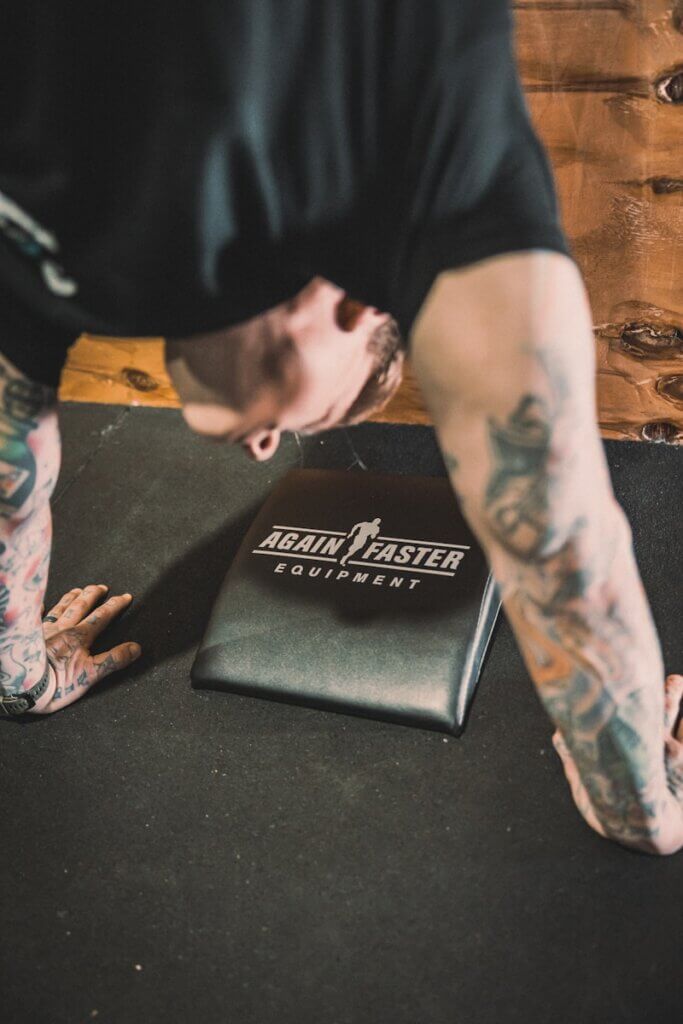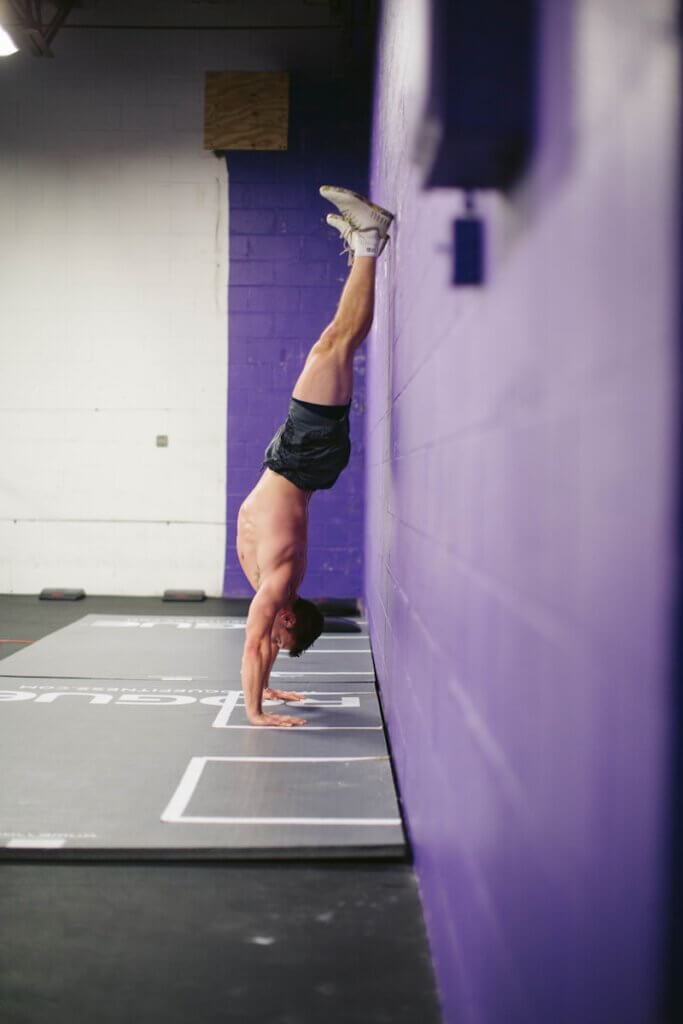How to do Kipping Handstand Push Ups

Introduction:
Kipping handstand push-ups are an advanced variation of the traditional handstand push-up that combines explosive hip movement with upper body strength to propel yourself upward. This dynamic exercise is a staple in CrossFit workouts, requiring coordination, agility, and core stability. Whether you’re aiming to improve your gymnastics skills or looking to challenge yourself with a new movement, mastering kipping handstand push-ups will take your fitness journey to the next level. In this guide, we’ll break down the fundamentals of kipping handstand push-ups, providing step-by-step instructions, essential equipment, scaling options, common mistakes to avoid, and the numerous benefits of incorporating them into your training regimen.
Steps in the Handstand Push Up movement
- Setup: Begin in a handstand position against a wall, with your hands placed shoulder-width apart and arms fully extended. Keep your core engaged and legs straight, toes pointed towards the ceiling.
- Kip: Initiate the movement by forcefully driving your hips upward, bending your knees and swinging your legs towards the wall.
- Press: As your hips reach their highest point, quickly straighten your legs and press through your palms to push your body away from the wall.
- Descend: Lower yourself back down to the starting position with control, bending your elbows and bringing your head towards the ground.
- Repeat: Continue the movement, generating momentum with each kip to propel yourself upward and complete multiple repetitions.
What Equipment is needed for Handstand Push Ups
- Wall: A sturdy wall is essential for practicing handstand push-ups, as it provides support and stability during the movement.
- Gymnastics mat (optional): Placing a mat under your head can provide cushioning and protection. An Abmat or specialized handstand push up mat can be used.
- Wrist wraps.
- Chalk, so not to slip with the hands.
Essential Equipment and Recommended Products
While kipping handstand push-ups primarily require minimal equipment, certain items can enhance your training experience. A quality pair of wrist wraps can provide support and reduce strain during the movement. Gymnastics grips can improve your grip on the floor, especially if your hands tend to get sweaty. A durable exercise mat not only offers comfort but also adds a layer of safety. Investing in resistance bands can be beneficial for assistance during progression drills and for mobility work. Additionally, wearing appropriate footwear with a flat sole can aid in maintaining balance during the exercise. Incorporating these tools can facilitate your progress and ensure a safer, more effective training session.
Check out the Equipment subsite for more tools, tips, and inspiration.

Shop Fitness gear now on Amazon
See Amazons extensive range of workout gear here. (Affiliate Link)
Scaling Options:
To gradually build strength and proficiency, consider the following scaling options:
- Wall-assisted kipping handstand push-ups: Begin with your feet resting on a wall for support, gradually reducing the amount of assistance as you gain strength and confidence.
- Kipping handstand push-ups with bands: Use resistance bands attached to the pull-up bar to assist with the kipping motion, reducing the difficulty of the exercise.
- Pike push-ups: Perform push-ups in a pike position with your hips raised, mimicking the movement pattern of kipping handstand push-ups while reducing the difficulty.
Prerequisite Strength and Mobility Requirements
Before attempting kipping handstand push-ups, it’s crucial to assess whether you possess the necessary strength and mobility to perform the movement safely. A solid foundation in upper body strength is essential, particularly in the shoulders, triceps, and core muscles. Being able to perform strict handstand push-ups demonstrates adequate strength and control, which are vital for the kipping variation. Additionally, shoulder mobility plays a significant role; limited flexibility can hinder your range of motion and increase the risk of injury. Incorporate shoulder mobility exercises, such as shoulder dislocates and wall slides, into your routine to enhance flexibility. Regularly practicing handstand holds against a wall can also help in building the necessary balance and stability. By ensuring you meet these prerequisites, you’ll set a strong foundation for mastering kipping handstand push-ups effectively and safely.
Common Mistakes to Avoid:
- Lack of core engagement: Keep your core tight throughout the movement to maintain stability and control, preventing excessive arching or sagging in the lower back.
- Incomplete range of motion: Ensure you lower your head all the way to the ground and fully extend your arms at the top of each rep to maximize the effectiveness of the exercise.
- Overarching neck: Keep your head in a neutral position, looking at the ground between your hands to prevent strain on the neck.
Benefits of the Movement:
- Builds upper body strength: Targets the deltoids, triceps, and upper back muscles, helping to develop overall shoulder strength and stability.
- Enhances explosive power: Utilizes the kipping motion to generate momentum and propel yourself upward, improving power output and athleticism.
- Increases cardiovascular endurance: Elevates heart rate and promotes cardiovascular health with high-intensity, full-body movements.

Which Muscles Are Worked:
During this exercise, the following muscle groups are engaged:
- Primary Muscles: Deltoids, triceps, upper back
- Secondary Muscles: Core, chest, forearms
Alternative Similar Movements:
If you’re seeking variation or targeting specific muscle groups, consider incorporating these alternative exercises:
Progression Drills for Skill Development
Mastering kipping handstand push-ups requires a structured approach through progression drills. Start with wall walks to build comfort in the inverted position and strengthen the shoulders. Progress to pike push-ups on a box, which simulate the pressing motion while allowing you to focus on form. Once proficient, practice the kipping motion separately by performing kipping swings on a pull-up bar to understand the hip drive mechanics. Combine these elements by attempting partial range of motion kipping handstand push-ups, gradually increasing the depth as strength and confidence improve. Consistent practice of these drills will develop the coordination and strength necessary for the full movement.

Shop Fitness gear now on Amazon
See Amazons extensive range of workout gear here. (Affiliate Link)
Detailed Warm-Up Routine
A comprehensive warm-up is essential to prepare your body for the demands of kipping handstand push-ups. Begin with general cardiovascular activity, like light jogging or jumping jacks, to increase overall blood flow. Follow this with dynamic stretches focusing on the shoulders, wrists, and thoracic spine to enhance mobility. Exercises such as arm circles, wrist flexor stretches, and thoracic rotations are beneficial. Incorporate activation drills like scapular push-ups and hollow body holds to engage the stabilizing muscles of the shoulders and core. This targeted warm-up not only reduces the risk of injury but also enhances performance by ensuring your muscles and joints are adequately prepared for the movement.
Safety Considerations and Injury Prevention
Safety should be a priority when performing kipping handstand push-ups. Ensure the surface you’re practicing on is non-slip and consider using mats to cushion any potential falls. Maintain a neutral spine throughout the movement to avoid undue stress on the neck and back. It’s advisable to have a spotter or coach present, especially when learning the movement, to provide assistance and feedback. Listen to your body and avoid pushing through pain; if discomfort arises, cease the activity and consult a healthcare professional. Regularly incorporating mobility work and allowing adequate rest between sessions can aid in preventing overuse injuries.
Q&A for Handstand kipping push ups
How to kip handstand pushups?
To kip handstand push-ups, initiate the movement by driving your hips upward, then use the momentum to press through your palms and straighten your legs as you reach the top. Practice coordinating the kip with the press to improve efficiency.
Are kipping handstand push ups hard?
Yes, kipping handstand push-ups are challenging because they require a combination of strength, coordination, and timing. However, with consistent practice, they become more manageable.
How to improve HSPU?
To improve handstand push-ups (HSPU), focus on building shoulder and core strength through exercises like pike push-ups and strict presses. Practicing handstand holds and kipping technique also helps.
Are handstand push-ups effective?
Yes, handstand push-ups are highly effective for building upper body strength, particularly in the shoulders, triceps, and upper back. They also enhance core stability and overall balance.
How many handstand pushups can the average man do?
The average man might struggle to do even one handstand push-up without prior training. With dedicated practice, achieving multiple reps is possible, but it varies greatly depending on individual strength and skill level.
Does kipping build muscle?
Kipping can help build muscle, especially in the shoulders, triceps, and core, as it allows you to perform more repetitions by using momentum. However, strict movements are generally better for hypertrophy.
Do handstands build lats?
Handstands primarily target the shoulders, triceps, and core, but they do engage the lats as stabilizers. To specifically build lats, incorporate pull-ups and rows into your training.
Why can’t I do a handstand pushup?
Inability to do a handstand push-up usually stems from insufficient upper body strength or poor technique. Focus on strengthening your shoulders, triceps, and core, and practice the movement consistently.
Will handstands build muscle?
Yes, handstands help build muscle in the shoulders, triceps, and upper back by holding your body weight. They also improve balance and core strength.
Why do CrossFitters have crazy abs?
CrossFitters often have well-defined abs due to the high-intensity, functional movements that engage the core, along with a disciplined diet and consistent training regimen.
Why are CrossFit athletes so muscular?
CrossFit athletes are muscular because the sport emphasizes a variety of high-intensity exercises that build strength and power. The combination of weightlifting, gymnastics, and metabolic conditioning promotes muscle growth.
Why are CrossFitters so lean?
CrossFitters tend to be lean because the training involves high-intensity workouts that burn a lot of calories and fat. Additionally, many follow strict nutrition plans to optimize performance and body composition.
Is CrossFit too hard on your body?
CrossFit can be demanding on the body, but with proper technique, adequate recovery, and a well-designed program, it can be safe and highly effective. Listening to your body and scaling workouts appropriately is key.
Conclusion:
Mastering kipping handstand push-ups requires dedication, practice, and perseverance, but the rewards are well worth the effort. Incorporate them into your training routine to unlock your full potential and take your fitness journey to new heights. So, kick up into that handstand, embrace the challenge, and let the power of the kip propel you to success!

Shop Fitness gear now on Amazon
See Amazons extensive range of workout gear here. (Affiliate Link)

🏋️ Written by: Mike Kerr
Mike is the founder of Strengthguides.com and a certified CrossFit Level 1 Trainer (CF-L1) and certified Kettlebell Instructor with over 10 years of experience in functional fitness. He specializes in developing programs that maximize performance without sacrificing mobility. Mike Kerr is passionate about making complex training methodologies comprehensible and safe for everyone.
